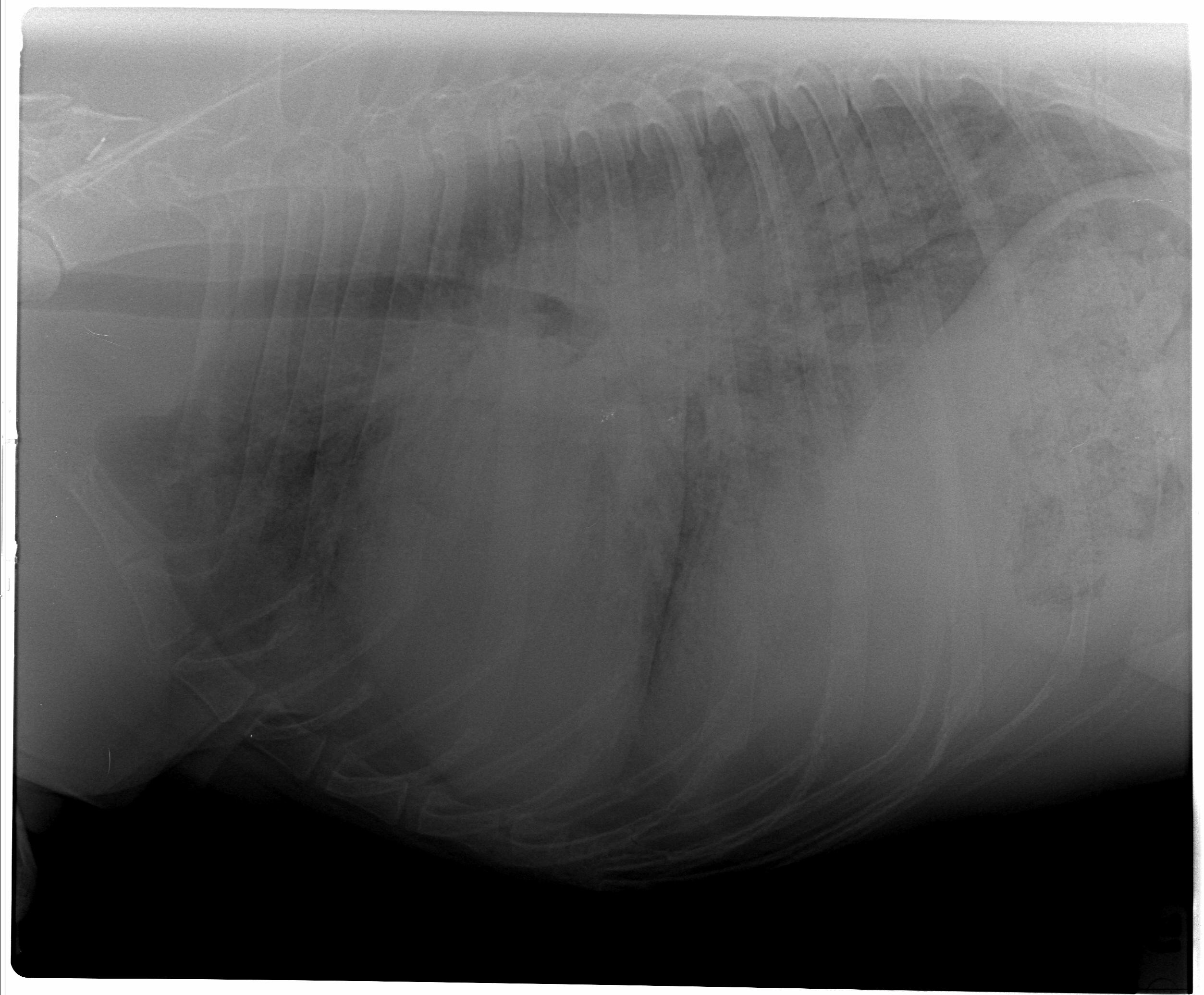
Athena
 Case Background
Case Background
Age: 6 years
Sex: Female
Breed: Doberman
Weight: 30 kg
Reason for Visit: Decreased appetite, cough and labored breathing
Medications: Amoxicillin 500mg: 1 capsule q 12hrs
 Clinical History
Clinical History
Please review Athena’s clinical history.
Attitude/Demeanor: Lethargic
Coughing: Coughing for two weeks
Abnormal Respirations: Increased respiratory effort over the last 2 days
Exercise Tolerance: Refusing to go on normal walks
Sleep Patterns: Prefers to lay in sternal recumbency which is atypical
Weight Change (loss or gain): None
Appetite: Has become very particular about food over the last 2 weeks
Usual Diet: Purina OM™, 4 cups per day
Vomiting: None
Diarrhea: None
Syncope: None
Change in urinary habits: None
Change in drinking habits: None
Other symptoms or signs: None
 Physical Exam - General
Physical Exam - General
Please review the results of Athena’s physical exam.
Body Condition: Good
Attitude: Quiet
Mobility | Gait: Ambulating normally
Posture: Standing or sternally recumbent
Hydration: Adequate
Body Temperature: 100.2 F
Arterial Pulse – rate, regularity, intensity: Weak, irregular pulses with a rate of 180/min with pulse deficits
Respiratory Effort: Increased respiratory effort.
Mucous Membranes – Color & CRT: Pale to pink / 3 seconds.
Jugular Venous Pulse & Pressure: No jugular distention
Abdominal Palpatation: Normal
Lymph Nodes: Normal.
Oral Cavity: Normal
Other Abnormalities: None
 Physical Exam - Auscultation
Physical Exam - Auscultation
Let’s auscult Athena’s heart & lungs.
 Physical Exam - Differential Diagnosis
Physical Exam - Differential Diagnosis
- High (could explain most or all of the signs)
- Possible (less likely to explain most of the signs)
- Unlikely
 Diagnostic Test Selection
Diagnostic Test Selection
 Blood Pressure
Blood Pressure
Diastolic Blood Pressure: Not available for this case
Mean Blood Pressure: Not available for this case
Consensus Statements of the American College of Veterinary Internal Medicine (ACVIM) provides the veterinary community with up-to-date information on the pathophysiology, diagnosis, and treatment of clinically important animal diseases. In 2018, ACVIM published guidelines for the Identification, Evaluation, and Management of Systemic Hypertension in Dogs and Cats in the the Journal of Veterinary Internal Medicine.
Click here to view and download a PDF of the ACVIM Consensus Statement, Guidelines for the Identification, Evaluation, and Management of Systemic Hypertension in Dogs and Cats.
 Radiographs
Radiographs
Please review Athena’s thoracic radiographs
Click here for Athena’s radiograph viewer (measure VHS and VLAS here) Click here for the right lateral view Clinical Labs
Clinical Labs
Please review Athena’s lab results
SERUM CHEMISTRIES
BUN: 24 mg/dL, Normal: 5 – 29 mg/dL
Creatinine: 1.7 mg/dL, Normal: 2.1 mg/dL
Sodium: 140 mmol/L, Normal:138 – 154 mmol/L
Potassium: 3.8 mEq/dL, Normal: 3.6 – 5.2 mEq/dL
Chloride: 115 mEq/dL, Normal: 105- 119 mEq/dL
ALT: 98 IU/dL, Normal: <75 IU/dL
ALP: 58 IU/dL, Normal: <100 IU/dL
Glucose: 140 IU/dL, Normal: 68 – 126 mg/dLHEARTWORM
Heartworm Test Results: NegativeURINALYSIS
Urinalysis – USG: 1.020
Urinalysis – Protein: Negative
Urinalysis – Biochemical: Negative
Urinalysis – Sediment Evaluation: NegativeCBC
White Blood Cells: 12,000/ul
Red Blood Cells: 41%
Platelets: 240,000/ul
 Echo
Echo
Please review the results of Athena’s echo.
Subjective – lesions of valves, myocardium, pericardial space: No valvular degeneration was seen. The left ventricular systolic function is subjectively reduced.
LV chamber size and thickness: There is severe left venticular eccentric dilation.
Left atrial size: The left atrium is moderately to severely enlarged.
LVIDd & LVIDs: Diastole (5.6 cm); Systole (5 cm).
LV shortening fraction: Left ventricular contractility is significantly reduced with a low fractional shortening of 11%.
RA, RV and Pulmonary Artery: Normal.
Effusions: No pleural or pericardial effusion.
Doppler results: There is moderate mitral valve regurgitation associated with geometric ventricular changes (dilation of the mitral valve annulus). Trivial tricuspid regurgitation.
Watch echo #1
 ECG
ECG
 Follow Up
Follow Up
7 Day Follow Up: Athena was released after diagnostic tests and instituting oral therapy for CHF. She was re-examined 7 days later. The owners have not noticed any coughing or labored breathing since discharge from the hospital. The appetite was reduced for the first 3 days, and is near normal today. Athena ws assessed with a renal panel, 8-hour post-pill serum digoxin concentration, ECG and thoracic radiographs. Renal panel: BUN=37mg/dl; creatinine 1.8mg/dl; phosphorus and electrolytes are within normal limits. Serum digoxin concentration: 0.9ng/dl (sample was drawn 6-8 hours post-pill into a red top tube without a serum separator. Eight-hour post-pill (trough) concentrations between 0.8 and 1.3 ng/dl are ideal to help with rate control and prevent toxicity signs. ECG: Rhythm is still atrial fibrillation, but the rate has been effectively reduced to an average of 150 bpm on the in-house rhythm strip. Thoracic radiographs: Left-sided cardiomegaly with a tall, upright heart consistent with left ventricular enlargement with a moderate to severe caudodorsal bulge consistent with left atrial enlargement. However, the caudodorsal interstitial pattern noted previously is absent on today’s films, and there has been improvement in the pulmonary venous distention. An increase in the furosemide dose is not warranted.


